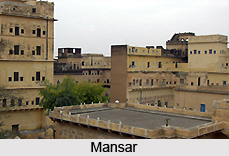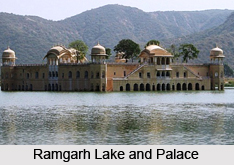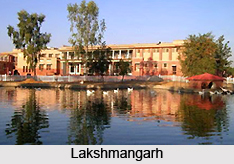 Places of Interest Around Fatehpur include Mahansar, Ramgarh and Lakshmangarh. Lying in the far north and west of Shekhawati these places have some of the most outstanding murals and Hindu monuments in the region are scattered across these three small towns. Ramgarh and Lakshmangarh are part of the day trip from Fatehpur. However the tourists can put up a stay at Mahansar as it has few but impressive accommodation units.
Places of Interest Around Fatehpur include Mahansar, Ramgarh and Lakshmangarh. Lying in the far north and west of Shekhawati these places have some of the most outstanding murals and Hindu monuments in the region are scattered across these three small towns. Ramgarh and Lakshmangarh are part of the day trip from Fatehpur. However the tourists can put up a stay at Mahansar as it has few but impressive accommodation units.
Mahansar: Marooned amid a sea of scrub and drifting sand this outstanding place is located 27 kilometers northeast of Fatehpur. Its monuments, which include a fortress and some of the most accomplished interior paintings in Shekhawati, are some of the finest instances of brilliant artistry. These places are, however, less frequented than the others. As a result Mahansar is a much more enticing prospect to the tourists. The travelers can also stay here and enjoy the surroundings of this place. It is also accessible from Mandawa, a forty-minute Jeep ride south.
As far as sightseeing is concerned there is the quirky Narayan Nimis Glide.Managed by Mahansar royal family in their crumbling 1768 abode, it consists of twelve rooms of varying standards. The rooms possess old rugs, bolsters, ancient carved wooden doors and raised sitting alcoves with views. It renders them with an element of romanticism. This heritage hotel is quite different from the others as it is an informal, slapdash establishment. But the ancient charm is intact in it and the prices here are also reasonable with excellent food. The travelers can check out the family heirlooms and sample the royal moonshine.
 Besides the fort there are painted buildings, which the traveler can check out if they want. Mahansar`s most beautiful murals are locked away out of sight in the Sona Ki Dukan Haveli, next to the main crossroads. The ceiling of the entrance hall to this mansion is exquisitely decorated with painted and richly gilded scenes from the Ramayana and Geet Govinda. These can be fully appreciated in the presence of pocket lights. The colors and mass of details can be elaborately observed.
Besides the fort there are painted buildings, which the traveler can check out if they want. Mahansar`s most beautiful murals are locked away out of sight in the Sona Ki Dukan Haveli, next to the main crossroads. The ceiling of the entrance hall to this mansion is exquisitely decorated with painted and richly gilded scenes from the Ramayana and Geet Govinda. These can be fully appreciated in the presence of pocket lights. The colors and mass of details can be elaborately observed.
Ramgarh: It is located at a distance of 20 kilometers north of Fatehpur. It was founded in 1791 and was to some extent a status symbol for the Poddar merchant family. They made every effort to outshine the nearby Churu, which they left following a dispute with the local thakur over wool tax. They had definitely achieved their aim, as there is not a single wall that has been left unattended. Even the shops in the bazaar are decorated with paintings. Most of the grand Poddar chhatris beside the main Churu-Sikar road preserve vibrant turquoise and vermilion murals depicting scenes from the Ramayana. The Poddar family havelis in the north of town, west of Churu Gate, are decorated with scenes from local folk stories, and a three-fish motif that is unique to Ramgarh.
There are holy shrines as well. Temples, such as, Natwar Niketan, Ram Lakshman and Ganga Mandir display scenes from the Hindu epics and local legends; the Shani temple in the northwest of town also holds some elaborate mirror work.
 Lakshmangarh: It is located at a distance of 20 kilometers south of Fatehpur. The prime local attraction here is the 19th century that dominates the west side of town. This ancient monument offers a spectacular view of the neighboring region. The travelers can climb up to its summit to enjoy the views. Lakshmangarh is easy to explore, thanks to a street grid inspired by that of Jaipur. The local bus stand is located just below the bus stand.
Lakshmangarh: It is located at a distance of 20 kilometers south of Fatehpur. The prime local attraction here is the 19th century that dominates the west side of town. This ancient monument offers a spectacular view of the neighboring region. The travelers can climb up to its summit to enjoy the views. Lakshmangarh is easy to explore, thanks to a street grid inspired by that of Jaipur. The local bus stand is located just below the bus stand.
Besides this the huge Char Chowk Haveli is built around four large courtyards (chowks). Though it is privately owned and entry is restricted but the design can be appreciated even from a distance. To see other excellent and amusing frescoes in Lakshmangarh the travelers can watch out for the heavily painted Kyal and Naria havelis in the southeast of town, the scenes of European women on walls near the clock tower, and Sanganeria Haveli, cast of the Radha Murli Manohar temple. At the far east of the town lies the bright but dilapidated Pansari Haveli. It is located near a chhatri and a well. Presently it is shelters a semi-permanent settlement of lohars, nomadic ironworkers.



















